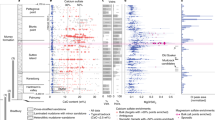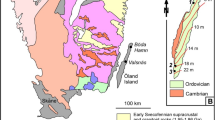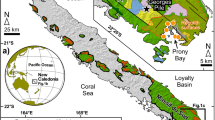Abstract
Models of formation of volcanic-hosted metal deposits hypothesize that subsurface brines transport metals to sites of deposition. Laguna Caliente, in the active crater of Poás volcano, central Costa Rica, consists of acid–sulphate–chloride brine with extreme pH (0.0). Lake water sampled between 9 and 12 January 1987 at eight sites within the 40-m deep, 210-m wide lake revealed temperatures between 58 and 64°C, and densities (measured in the laboratory at 60°C) of 1.0575±0.0015g cm–3. The water's extreme acidity reflects the dominating input of acid fumaroles. The presence of precipitated silica, gypsum and sulphur as sediments reflects lake-water equilibrium with those phases. Mass balance considerations require that dense brines percolate downwards from the lake into the volcano. These may act as a source of metal-rich brine feeding an underground ore-forming hydrothermal system.
This is a preview of subscription content, access via your institution
Access options
Subscribe to this journal
Receive 51 print issues and online access
$199.00 per year
only $3.90 per issue
Buy this article
- Purchase on Springer Link
- Instant access to full article PDF
Prices may be subject to local taxes which are calculated during checkout
Similar content being viewed by others
References
1. Casertano, L. et al. Geof. Int. 24-2, 315-332 (1985). 2. Barquero, J. SEAN Bull. 12 (8) (in the press). 3. Reynolds, J. thesis. Dartmouth Coll. (1985). 4. Shepherd, J. B. & Sigurdsson, H. Nature 271, 344-345 (1978). 5. Henley, R. W. in Geology and Geochemistry of Epithermal Systems (eds Berger, B. R. & Bethke, D. M.) 1-24 (Society Economic Geologists, El Paso, Texas, 1985). 6. Anuario Meteorologico, 1976-83 (Institute Meteorologico Nacional, San Jose, Costa Rica). 7. Giggenbach, W. N.Z. J. Sci. 17, 33-45 (1974). 8. Casadevall, T. J. et al J. Volcan. geotherm. Res. 23, 169-191 (1984). 9. Sillitoe, R. H. Econ. Geol. 68, 799-815 (1973). 10. Hayba, D. O., Bethke, P. M., Heald, P. & Foley, N. K. in Geology and Geochemistry of Epithermal Deposits (eds Berger, B. R. & Bethke, P. M.) 129-268 (Society Economic Geologists, El Paso, Texas, 1985). 11. del Rosario Alfaro, M., Fernandez, E., Barquero, J., Rodriguez, J. J. & Rodriguez, M. Bol. Vole. 17, 15-22 (1986). 12. Prosser, J. & Carr, M. J. Volcan. Geotherm. Res. (in the press). 13. Dansgaard, W. Tellus 16, 436-468 (1964).
Author information
Authors and Affiliations
Rights and permissions
About this article
Cite this article
Brantley, S., Borgiatt , A., Rowe, G. et al. Poás volcano crater lake acts as a condenser for acid metal-rich brine. Nature 330, 470–472 (1987). https://doi.org/10.1038/330470a0
Received:
Accepted:
Issue Date:
DOI: https://doi.org/10.1038/330470a0
This article is cited by
-
Solid sulfur spherules near fumaroles of Hakone volcano, Japan
International Journal of Earth Sciences (2019)
-
Epithermal paleosurfaces
Mineralium Deposita (2015)
-
A photographic method for detailing the morphology of the floor of a dynamic crater lake: the El Chichón case (Chiapas, Mexico)
Limnology (2011)
Comments
By submitting a comment you agree to abide by our Terms and Community Guidelines. If you find something abusive or that does not comply with our terms or guidelines please flag it as inappropriate.



